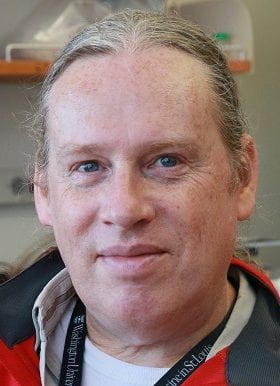NGI affiliated lab includes any faculty using high-throughput omic data to understand the pathobiology of human with focus on leverage human samples to study neurodegenerative diseases. There is no cost to join, but there are many benefits to becoming an NGI Center Affiliated lab member. If you are not yet affiliated with the NGI Center but would like to be, please click here

Sharlee Climer, PhD
- Phone: 314-516-4985
- Email: climber@umsl.edu
Primary research interest is the development of combinatorial methods for biological applications. A key focus is to identify patterns in genetic data, such as the one shown at the top of this webpage, and determine associations of these patterns with traits of interest, such as Alzheimer disease.

Jonathan Cooper, PhD
- Phone: 314-273-9066
- Email: cooperjd@wustl.edu
For the last 20 years, work in Jonathan Cooper’s Pediatric Storage Disorders Laboratory (PSDL) has focused upon investigating the pathogenesis of the neuronal ceroid lipofuscinoses (NCLs, or Batten disease), and other similar neurodegenerative lysosomal storage disorders. They have unbiased stereology to characterize multiple mouse and larger animal models NCL, and have used this information in order to be able to target a range of different pre-clinical interventions to where they can be most effective. This work has led to several clinical trials and an approved treatment for CLN2 disease.

Joseph Corbo, MD, PhD
- Phone: 314-362-6254
- Email: jcorbo@wustl.edu
A major effort of Corbo lab is directed toward understanding the transcriptional regulatory networks that orchestrate the development and function of photoreceptors. They are employing a wide range of experimental and computational techniques to decipher these networks. Recently, they generated comprehensive maps of rod- and cone-specific open chromatin using ATAC-seq and have leveraged these maps to elucidate the differences in cis-regulatory grammar between these two cell types. They are now using a massively parallel reporter assay called CRE-seq to further interrogate the architecture of photoreceptor cis-regulatory elements. Our ultimate goal is to create a complete, quantitative model of photoreceptor transcriptional regulation including a detailed cis-regulatory grammar. This model will serve as a template for translating between both coding and non-coding variants and the complex cellular phenotypes of photoreceptors that result in blindness.

Anne Cross, MD
- Phone: 314-362-3293
The goal of our research is to understand the mechanisms involved in pathogenesis of inflammation and demyelination in the central nervous system (CNS-brain and spinal cord). Our studies utilize detailed and quantitative imaging of human CNS, with cutting edge techniques developed at this institution. Other studies employ animal models for the human disease multiple sclerosis (MS), such as experimental autoimmune encephalomyelitis (EAE) and cuprizone toxicity models. Together with the laboratory of Hope Center member Dr. Laura Piccio, we study the effects of adipokines (cytokines derived from adipose tissue) in animal models of MS. We are currently funded to a) use an imaging method called Gradient Echo Plural Contrast imaging in a longitudinal study of patients with different subtypes of MS, b) use diffusion imaging to study MS brains and spinal cords, and c) to perform an open-label study of every-other-day fasting in MS patients undergoing relapse.

Patricia Dickson, MD
- Phone: 314-454-6093
The Dickson laboratory studies the mucopolysaccharidosis (MPS) disorders, which are lysosomal enzyme deficiencies affecting the catabolism of glycosaminoglycans. Central nervous system manifestations include progressive intellectual disability, communicating hydrocephalus, dysmyelination, spinal cord compression, and cortical atrophy. Our lab studies cerebrospinal fluid delivery of recombinant enzymes to treat central nervous disease due to MPS, and has demonstrated biodistribution of intrathecally-delivered recombinant enzymes throughout the neuroaxis of MPS models, with correction of lysosomal storage. The laboratory also studies neuroimaging and neuropathology of white matter in MPS brain and the humoral immune responses to therapeutic enzymes. Projects range from bench to bedside including clinical trials.

Christopher Dy, PhD
Dedicated to conducting brachial plexus and peripheral nerve research that is directly relevant to patients, clinicians, scientists, and policy-makers. The lab has 2 components: (1) Epidemiologic, economic, and clinical analysis of brachial plexus injuries and (2) Translational nerve research.

Gabor Egervari, MD, PhD
- Email: gabor@wustl.edu
I am interested in exploring the emerging interface between cellular metabolism and epigenetic mechanisms. Recent evidence suggests that transcriptional regulation is tightly linked with intermediary metabolism via the availability of substrates and co-factors for epigenetic enzymes. In addition, metabolic enzymes are recruited to the nucleus and chromatin to control local levels of specific metabolites. I am particularly interested in the role of the epigenetic-metabolic axis in the brain during learning and memory, with emphasis on alcohol use disorder and Alzheimer’s disease.

Wei Feng, PhD
- Email: fwei@wustl.edu
We integrate multiple cutting-edge computational and experimental approaches to study gene transcriptional regulation in the nervous system and how changes in the regulation contribute to neurodegenerative diseases such as Alzheimer’s disease (AD), Parkinson disease (PD) and Lewy body diseases (LBDs).

Nelly Friedrichsen, PhD
- Phone: 3142738261
- Email: n.joseph@wustl.edu
The Benzinger Lab uses novel position emission tomography (PET) and magnetic resonance imaging (MRI) images to investigate biomarkers in aging and neurodegenerative diseases very early.

Robert Gereau, PhD
- Email: gereaur@wustl.edu
Gereau Lab utilizes a combination of behavioral studies, patch clamp electrophysiology, optogenetics, in vivo imaging, molecular and genetic approaches to understand the signaling pathways involved in nervous system plasticity that underlies pain sensitization. Their mission is to identify novel approaches to reverse this maladaptive plasticity to provide new therapeutic strategies to reduce pain and its impact on patient quality of life.